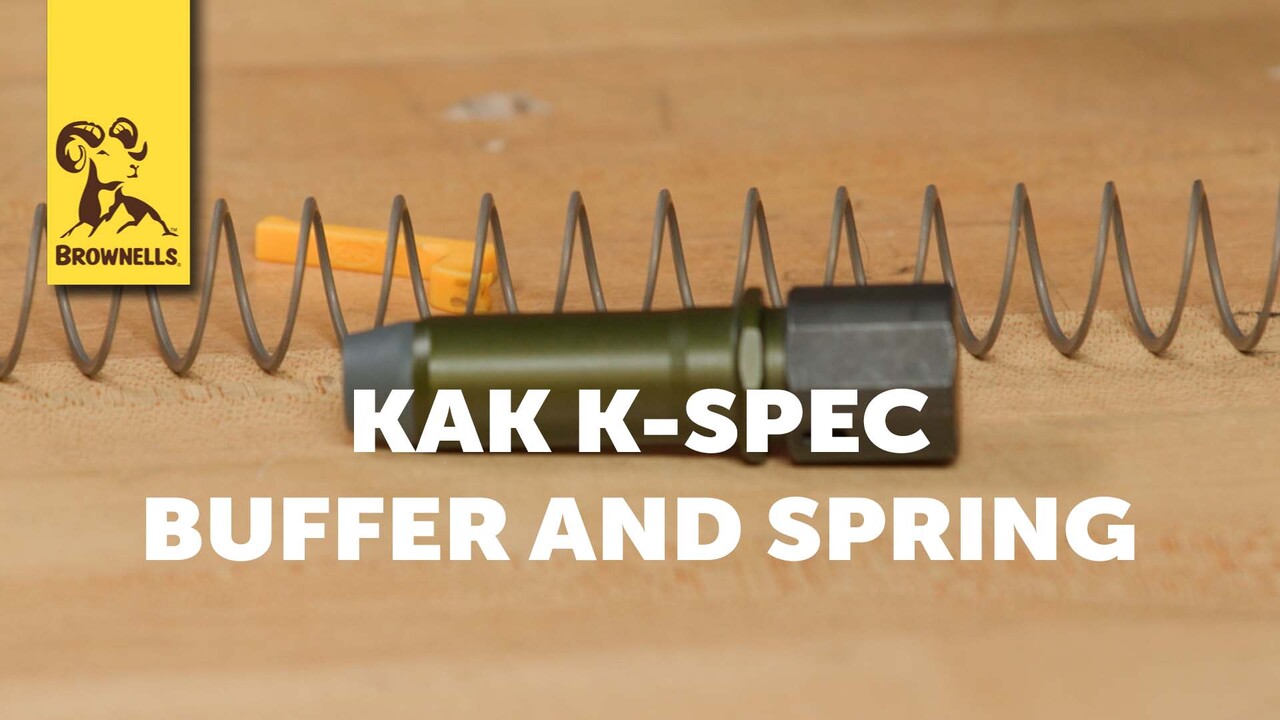Product Spotlight: KAK K-Spec Buffer and Spring
In this Brownells Product Spotlight, Caleb discusses the KAK K-SPEC Buffer and Spring, a component designed to enhance the reliability and performance of AR-15 rifles. The video highlights how this buffer system works in conjunction with other K-SPEC components to provide a smoother shooting experience. Caleb explains the design features that contribute to improved recoil management and overall firearm function.
What You Will Learn
Viewers will gain insights into the specific features of the KAK K-SPEC Buffer and Spring, including how it integrates with other parts to optimize rifle performance
Benefit
The video provides valuable information for those looking to upgrade their AR-15 with components that offer enhanced reliability and shooting comfort.
Introduction
Hey everyone, Caleb here from Brownells! In today’s Product Spotlight, we’re taking a look at the KAK K-Spec Buffers from KAK Industries. These buffers are designed to reduce bolt bounce and improve reliability, especially in suppressors, pistol caliber carbines, and full-auto firearms. While KAK also makes standard-style buffers, we’re focusing on the unique design of the K-Spec buffers. Let’s dive into the details!
Standard Buffers vs. KAK K-Spec Buffers
First, KAK offers standard-style buffers, like the A5 length buffers I have here. One of the cool things about these standard buffers is that KAK has color-coded the back of the buffer so you can quickly identify the weight. This is a huge improvement over the usual method of picking up the buffer and shaking it to figure out what weight you have, which is a hassle. But today, we’re not here to talk about these standard buffers. We’re going to focus on the KAK K-Spec buffer system, which takes things to the next level in terms of performance and innovation.
KAK Flat Wire Recoil Spring
One thing to note is that the K-Spec buffers come as part of a kit, which includes a flat wire recoil spring. The spring is high-quality, and while I’ve never been a huge fan of flat wire springs in the past, I decided to give these a try. After using them, I’ve been impressed with how well they perform. Flat wire springs offer certain advantages in terms of durability and consistent pressure. They work well with the K-Spec system, providing smooth operation and reducing potential binding issues.
Two-Piece KAK K-Spec Buffer Design
Now, let’s talk about what makes the K-Spec buffer unique. Unlike traditional buffers that are one solid piece, the K-Spec buffer is a two-piece design. The body of the buffer is made of aluminum, but the head is steel. What’s interesting is that the steel head is under spring tension and actually reciprocates. This means that when the buffer is in motion, the head can compress slightly. The result is a buffer system that reduces felt recoil and bolt bounce. While I didn’t personally notice a huge reduction in recoil (because my rifles are already tuned), this system can be a game changer for shooters dealing with bolt bounce, particularly in pistol caliber carbines or full-auto guns.
Bolt Bounce Elimination
One of the primary benefits of the KAK K-Spec buffer system is the elimination of bolt bounce. In a standard buffer system, the bolt can bounce slightly after slamming into the chamber, potentially causing malfunctions. With the K-Spec buffer, the steel head compresses upon impact, absorbing some of that energy and keeping the bolt in battery. This feature is especially useful for full-auto firearms and suppressor setups, where bolt bounce can be a significant issue. It’s also a great option for pistol caliber carbines, which are notorious for bolt bounce problems. By keeping the bolt stable, the K-Spec buffer enhances reliability across the board.
Installation Challenges and Tips
When I first tried to install the K-Spec buffer, I ran into a bit of a problem. After inserting the spring and buffer into the buffer tube, the buffer detent got caught between the flat wire spring and the gap between the buffer head and the body. It was frustrating, and I had to use a tool to get it seated properly. That’s when I realized that the plastic piece included in the packaging was actually an installation tool. I had discarded it initially, thinking it wasn’t necessary, but it turns out this little tool makes installation much smoother. While you don’t absolutely need it, it’s handy to have, especially for installing and uninstalling the buffer and spring.
Using the Installation Tool
Here’s how the installation tool works. First, you open your rear takedown pin, then place the tool into the buffer detent channel. The small lip on the tool will hold the detent down, allowing the buffer and spring to slide in easily without catching. After inserting the buffer and spring, you close the takedown pin, which locks the tool in place and holds the detent down. This little tool makes the process much smoother and prevents you from damaging or bending the detent or spring. It’s a simple solution that adds convenience to the installation process. Inserting the Buffer and Spring Once the tool is in place and the detent is held down, you can easily insert the buffer and spring into the buffer tube. After everything is seated properly, remove the tool by opening the takedown pin. The detent will pop up, locking the buffer and spring into place. This installation process works for any buffer system, not just the K-Spec buffer, so it’s a useful tip even if you’re working with standard buffers and springs.
Closing Remarks
That’s a wrap on the KAK K-Spec Buffer System! This buffer reduces bolt bounce, improves reliability, and works well with suppressors, pistol caliber carbines, and full-auto firearms. If you’re looking for a buffer system that











